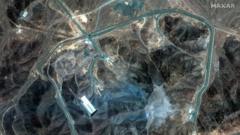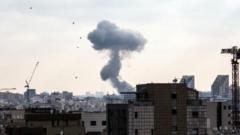**A detailed Pentagon briefing reveals how the complex operation unfolded, raising questions about the future of US-Iran relations.**
**US Airstrikes on Iran: Inside the Coordinated Military Operation**

**US Airstrikes on Iran: Inside the Coordinated Military Operation**
**In a meticulously planned assault, the US executed a surprise attack on Iran's nuclear facilities using advanced military strategies and technology.**
In a significant military escalation, the United States has reportedly conducted a series of airstrikes targeting Iran's nuclear infrastructures, a move termed 'Operation Midnight Hammer'. Four-star General Dan Caine, the Chairman of the Joint Chiefs of Staff, detailed the elaborate operation during a Pentagon briefing, emphasizing the intricate coordination involved. While the full ramifications of the operation are yet to be determined, initial reports depict a highly complex execution involving deceptive measures and advanced weaponry.
The offensive commenced shortly after midnight, with top military and political officials, including President Donald Trump, closely monitoring the operation from the White House Situation Room. A fleet of seven B-2 stealth bombers, capable of evading radar detection, launched from Whiteman Air Force Base, heading covertly over the Atlantic towards Iran's heavily fortified nuclear sites.
Using a combination of mid-air refuelings and misinformation tactics, including decoy flights towards Guam, the US military aimed to divert global attention while ensuring the safety of its strike force. With the bombers equipped with "bunker buster" bombs, designed to penetrate deep concrete structures, they targeted the Fordo facility, one of the primary hubs of Iran's nuclear ambitions, buried deep beneath mountainous terrain.
As the operation unfolded, US officials reported a lack of Iranian defensive response—an observation attributed to Israeli control over the airspace. The Pentagon stated that upon reaching the Middle East, the bombers were escorted by additional aircraft to mitigate potential threats. In the coordinated assault, over two dozen Tomahawk missiles were launched from a nearby submarine, enhancing the strike's effectiveness as they targeted multiple sites simultaneously.
The specifics of the operation painted a picture of tactical success, with bombers executing a high-precision strike on Fordo and another facility at Natanz. Experts familiar with military operations highlighted this mission as unprecedented, marking the first live use of the Massive Ordnance Penetrator bombs in combat.
Despite government declarations of a "total victory" over Iran's nuclear capabilities, experts caution that the effectiveness of the strikes and their potential impact on Iran's nuclear timeline remain uncertain. As the world awaits more evidence, the fallout from this operation could redefine international relations regarding Iran's nuclear aspirations and US military engagement in the region.





















